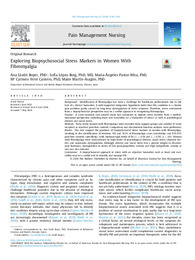Please use this identifier to cite or link to this item:
https://hdl.handle.net/11000/33583Full metadata record
| DC Field | Value | Language |
|---|---|---|
| dc.contributor.author | Lledó, Ana | - |
| dc.contributor.author | López Roig, Sofía | - |
| dc.contributor.author | Pastor-Mira, María Ángeles | - |
| dc.contributor.author | Terol Cantero, M Carmen | - |
| dc.contributor.author | MARTÍN-ARAGÓN, MAITE | - |
| dc.contributor.other | Departamentos de la UMH::Ciencias del Comportamiento y salud | es_ES |
| dc.date.accessioned | 2024-10-22T08:13:50Z | - |
| dc.date.available | 2024-10-22T08:13:50Z | - |
| dc.date.created | 2024 | - |
| dc.identifier.citation | Pain Management Nursing 25 (2024) | es_ES |
| dc.identifier.issn | 1524-9042 | - |
| dc.identifier.uri | https://hdl.handle.net/11000/33583 | - |
| dc.description.abstract | Background: Identification of fibromyalgia has been a challenge for healthcare professionals due to the lack of a clinical biomarker. A well-supported integrative hypothesis holds that this condition is a chronic pain problem partly caused by long-term dysregulation of stress response. Therefore, stress assessment from a biopsychosocial perspective may be a useful approach to recognizing fibromyalgia. Purpose: A cross-sectional case-control study was conducted to explore stress markers from a multidi- mensional perspective, including heart rate variability (as a biomarker of stress) as well as psychological distress and social stress. Methods: Forty-seven women with fibromyalgia were recruited from support groups and another 47 were recruited as matched pain-free controls. Comparison and discriminant function analyses were performed. Results: The data support the goodness of biopsychosocial stress markers in women with fibromyalgia, resulting in the identification of between 70% and 74.5% of fibromyalgia cases (sensitivity) and 85%-87% pain-free controls (specificity), with medium-high levels of fit ( λ= 0.58 and λ= 0.59; p < .00). Women with fibromyalgia were characterized by high levels of psychological distress, social stress (disorder lev- els), and autonomic dysregulation. Although distress and social stress had a greater weight in discrimi- nant functions, dysregulation in terms of low parasympathetic activity and high sympathetic activity at rest was also relevant. Conclusions: A biopsychosocial approach to stress with an objective biomarker such as heart rate vari- ability may be a useful tool to identify and manage FM. | es_ES |
| dc.format | application/pdf | es_ES |
| dc.format.extent | 10 | es_ES |
| dc.language.iso | eng | es_ES |
| dc.publisher | Elsevier | es_ES |
| dc.rights | info:eu-repo/semantics/openAccess | es_ES |
| dc.rights.uri | http://creativecommons.org/licenses/by-nc-nd/4.0/ | * |
| dc.subject.other | CDU::1 - Filosofía y psicología::159.9 - Psicología | es_ES |
| dc.title | Exploring Biopsychosocial Stress Markers in Women With Fibromyalgia | es_ES |
| dc.type | info:eu-repo/semantics/article | es_ES |
| dc.relation.publisherversion | https://doi.org/10.1016/j.pmn.2024.05.008 | es_ES |

View/Open:
1-s2.0-S152490422400167X-main.pdf
2,71 MB
Adobe PDF
Share:
.png)
